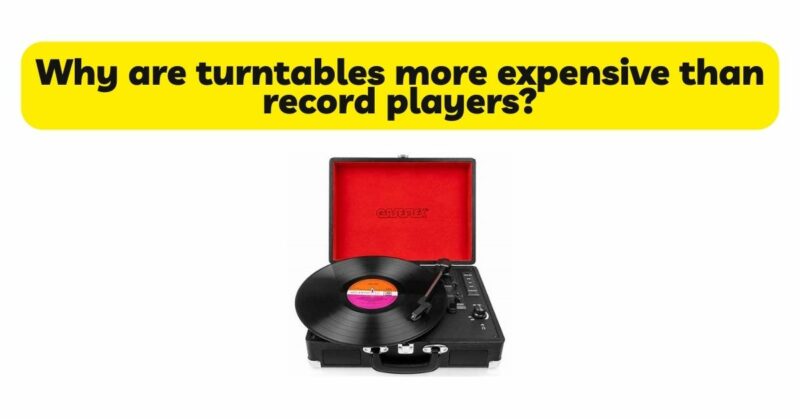The resurgence of vinyl records in recent years has brought analog audio playback back into the limelight. As music lovers dive into the world of vinyl, they often encounter a price discrepancy between turntables and record players. While both devices serve the purpose of playing vinyl records, turntables tend to command a higher price tag compared to record players. In this article, we will explore the reasons behind the price disparity and shed light on why turntables are generally more expensive than record players.
- Build Quality and Materials: One of the key factors contributing to the price disparity between turntables and record players lies in the difference in build quality and materials used. Turntables are often crafted with precision and attention to detail, employing high-quality components and materials. The plinth, which houses the internal components, is commonly made from dense, resonance-resistant materials like solid wood or acrylic. Additionally, turntables often feature heavy, precision-machined platters that minimize vibration and provide more stable playback. In contrast, record players are typically constructed with lighter and less expensive materials to reduce manufacturing costs, resulting in a lower price point.
- Motor and Speed Stability: Turntables prioritize speed stability and accuracy, which necessitates the inclusion of more robust and reliable motors. Higher-end turntables often feature direct-drive or belt-drive systems that offer consistent rotation speeds, minimizing fluctuations that can affect audio quality. These motors require precise engineering and sophisticated control mechanisms, contributing to the higher cost. On the other hand, many record players utilize simpler, less expensive motor mechanisms that may sacrifice speed stability, resulting in potential variations in playback quality.
- Tonearm and Cartridge Quality: The tonearm is a critical component of any vinyl playback system, responsible for tracking the record grooves and translating the vibrations into electrical signals. Turntables commonly employ tonearms with higher build quality, precision bearings, and superior tracking capabilities. These tonearms allow for accurate tracing of the record’s grooves, minimizing distortion and optimizing sound reproduction. Additionally, turntables often come with removable and upgradable cartridges, allowing users to fine-tune their audio experience. In contrast, record players usually feature fixed, non-upgradable tonearms and cartridges, which can limit their overall performance and flexibility.
- Adjustability and Fine-tuning Options: Turntables offer a higher degree of adjustability and fine-tuning options compared to record players. They typically provide features such as adjustable counterweights, anti-skate mechanisms, and height-adjustable tonearms, allowing users to optimize tracking force, minimize distortion, and ensure precise playback. These adjustable elements require meticulous engineering and add to the manufacturing costs of turntables. In contrast, record players often come with limited or fixed settings, providing less flexibility for optimizing audio performance.
- Audiophile-Grade Components and Performance: Turntables cater to the demands of audiophiles and enthusiasts who prioritize superior sound quality. To meet these expectations, high-end turntables incorporate premium components, such as high-fidelity cartridges, precision stylus assemblies, and advanced vibration isolation systems. These components are carefully selected and engineered to deliver optimal audio performance, resulting in a more immersive and detailed listening experience. Record players, designed for casual listeners, generally feature more modest components that prioritize affordability over top-tier sound reproduction.
- Research and Development: The development of turntables involves extensive research, engineering, and innovation. Manufacturers invest significant resources in designing and refining turntables, pushing the boundaries of audio performance. These research and development efforts contribute to the overall cost of turntables. In contrast, record players often rely on more standardized designs and technologies, which reduces development costs and results in more budget-friendly options.
- Niche Market and Production Volume: Turntables cater to a nichemarket of enthusiasts, audiophiles, and DJs who value high-quality audio playback. The demand for turntables may be lower compared to record players, which are more accessible to casual listeners. Consequently, the lower production volume of turntables can drive up their cost. Manufacturers often produce turntables in smaller quantities, resulting in economies of scale that favor mass-produced record players, making them more affordable.
- Branding and Prestige: Certain turntable brands have established a reputation for excellence and craftsmanship over the years. These brands often command a premium due to their reputation, history, and the perceived value associated with their products. Turntables from these renowned brands are often meticulously handcrafted and built to exacting standards, contributing to their higher price tags. Record players, on the other hand, may not possess the same level of prestige and brand recognition, resulting in a lower price point.
Conclusion: The price disparity between turntables and record players can be attributed to a combination of factors, including differences in build quality, materials, motor and speed stability, tonearm and cartridge quality, adjustability options, use of premium components, research and development efforts, market demand, and brand reputation. Turntables, designed to meet the expectations of discerning audiophiles and enthusiasts, prioritize superior sound reproduction, precision engineering, and customization options. Record players, on the other hand, offer a more affordable and accessible entry point into vinyl playback, with simpler designs and fewer features.Ultimately, the decision between a turntable and a record player depends on individual preferences, budget, and the desired level of audio fidelity. While turntables may come with a higher price tag, they offer a more immersive and customizable audio experience for those who seek the utmost in sound quality and performance. Record players, on the other hand, provide an affordable and straightforward option for casual listeners who wish to enjoy the vinyl revival without delving into the complexities and costs associated with high-end turntables.


